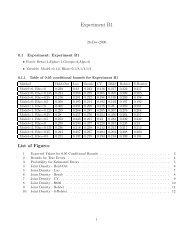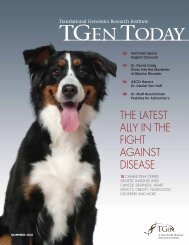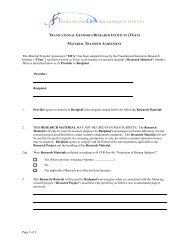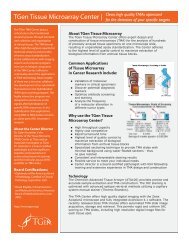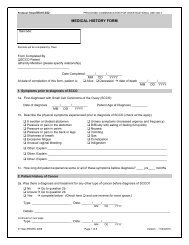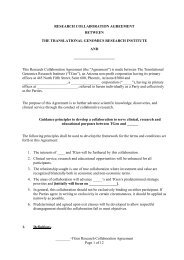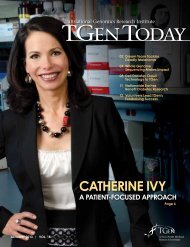SPECIAL ISSUE - Translational Genomics Research Institute
SPECIAL ISSUE - Translational Genomics Research Institute
SPECIAL ISSUE - Translational Genomics Research Institute
Create successful ePaper yourself
Turn your PDF publications into a flip-book with our unique Google optimized e-Paper software.
TGen Today | 1<strong>Translational</strong> <strong>Genomics</strong> <strong>Research</strong> <strong>Institute</strong>22 Cover StoryTGen Launches the C4RCDThe TGen Center for Rare Childhood Disorders (C4RCD) harnessesthe latest technologic leaps in genome sequencing, pinpointingcauses of rare childhood disorders3 4681012 143468101213BackCover$1 million gift creates TGen CLIA LabThanks to a $1 million donation from the Dorrance FamilyFoundation, TGen now has its own federally-certified labTGen launches CLIA LabPatients benefit from timely analysis, lower costs of TGen’sgenomic sequencingTGen’s Medical MiracleShelby’s dramatic improvement prompted TGen officialsto establish the C4RCDBelnap family puts faith in TGenThree of four children are diagnosed with Mitochondrial Disease;parents credit TGen with saving one son’s lifeChasing a diagnosisTGen’s C4RCD program provides closure for the familyof Ryder Cash HauerEmbracing the C4RCDIn memory of their ‘warrior’ son, the Laffoon family nowseeks to help others through TGenAdvisory panels help guide programTGen’s C4RCD has established a National Advisory Committeeand a Parent Advisory CommitteeHow to get involvedFind out how to participate in TGen’s C4RCD research, anddonate to help more children with rare disordersAbout TGen |The <strong>Translational</strong> <strong>Genomics</strong> <strong>Research</strong> <strong>Institute</strong> (TGen) is a non-profit organization dedicated to conducting groundbreaking research with lifechanging results. <strong>Research</strong> at TGen is focused on helping patients with diseases such as cancer, neurological disorders and diabetes. TGen ison the cutting edge of translational research where investigators are able to unravel the genetic components of common and complex diseases.Working with collaborators in the scientific and medical communities, TGen believes it can make a substantial contribution to the efficiencyand effectiveness of the translational process. For more information, visit: www.tgen.org
TGen Today | 3Grandchild’srare disorderinspiresDorrancefamilyphilanthropyBennett and Jacquie Dorrance with Dr. John Carpten officially open the CLIA laboratory at a ribbon cutting ceremony$1 Million Gift Creates TGen CLIA LabBennett and Jacquie Dorrance, supporters of TGen sinceits inception, know what it’s like to go without answers.Their grandson, Anton Baiker, was born with a rarechildhood disorder that went undiagnosed until age 4, whenhe was enrolled in a groundbreaking study at TGen.His first year of life, he required a feeding tube and wasfrequently in hospitals as his mother, Ashley Kaplan, searchedin frustration for explanations about what caused hisabnormal fevers, cold sweats, and his unusual response topain. It was unknown if his condition would worsen.“Every day was a guessing game,” Ashley said. “I had no ideawhy he was the way he was.”Aided by expert assessment of his condition, TGen scientistssequenced and analyzed his genome. Doctors diagnosed himclinically with Crisponi syndrome, an extremely rare conditiongenerally characterized by excessive muscle contractions,fevers, seizures, hyperthermia and respiratory problems.Now, at age 6, Anton is doing well, even excelling at soccer.Ashley said that with a diagnosis, she and Anton are betterequipped to deal with his condition and anticipate the future.“We would never have been sure about what he had withoutTGen’s intervention,” said Jacquie Dorrance, who empathizeswith other families of children with rare childhood disorders.“There are so many families going through this agony andnightmare of not knowing. This is made especially difficultafter having taken their children to hospitals all over thecountry and still coming up with no solutions or leads.”TGen’s whole genome sequencing spells out the 3 billionletters of each patient’s DNA, enabling researchers to identifypotential problems in their genetic code.“That makes all the difference,” Jacquie said. “Just knowingwhat it is. Just having some idea of what your child has. It’s justhuge. Putting a name on it. Not feeling like you’re totally in thedark. That’s why we’re so involved in the C4RCD.”One of the key ingredients to quickly sequencing andanalyzing a patient’s genome is access to a laboratorycertified under CLIA, Clinical Laboratory ImprovementAmendments, passed by Congress in 1988 to ensure qualitylaboratory testing.Thanks to a $1 million donation from the DorranceFamily Foundation, TGen now has its own CLIA lab, recentlychristened the Dorrance Clinical Laboratory. This new lab willenable the C4RCD to quickly find answers for more familieslike the Dorrance’s.“We are extremely grateful for the tremendous support wehave received over the years from the Dorrance’s,” said Dr.John Carpten, TGen’s Deputy Director for Basic Science. “Thisnew lab represents a quantum leap for the capacity of TGen toconduct our science and make new strides to benefit patientsas quickly as possible.”Having its own CLIA lab means TGen doesn’t have to waitweeks or months working with an outside CLIA facility tocomplete the analysis of a patient’s genome. Instead, it can becompleted in-house in as little as a three or four days.“That’s the amount of time you need to do things, not threeor four months,” said Bennett, noting that a quickturn-around makes the sequencing data beneficial for thetreating physician.Bennett is amazed at the progress TGen has made over thepast 10 years since its establishment in 2002, and he believesthe progress and commitment to rapid translational medicinewill continue under the leadership of TGen President andScientific Director Dr. Jeffrey Trent.“The advances in the last 10 years have been stunning. Jeffhas accomplished so much more than I ever thought waspossible,” Bennett said. “TGen does things differently. Theywill continue to do it with Jeff at the helm. They’ll continue topartner. They’ll continue to think out of the box. The statusquo just isn’t cutting it. TGen is always going to be pushingthe envelope.”
4 | TGen TodayPatientsbenefit fromtimely analysisof DNAsequencingDr. Lisa Baumbach-Reardon (left) and Dr. Janine LoBello (right) are CLIA Lab Co-DirectorsTGen LaunchesAs more TGen studies use whole genomesequencing — decoding DNA to determinea patient’s molecular make-up — TGen hasa growing potential to share clinically relevant testresults with patients and their oncologists.Sharing that information is a cornerstone ofTGen’s ongoing initiative to help provide patientsand their physicians with personalized therapeutics.But to share that information, TGen’s studiesmust be performed, or confirmed, in laboratoriescertified under Clinical Laboratory ImprovementAmendments (CLIA), passed by Congress to ensurequality laboratory testing.Until now, TGen has contracted with outsideCLIA-certified laboratories. This has meantan oftentimes cumbersome, costly and timeconsumingback-and-forth exchange of data amongthe parties involved in our studies, sometimesadding as much as four weeks to generate a report forthe patient.Thanks to a $1 million grant from the DorranceFamily Foundation, TGen has created an inhouseCLIA Laboratory on the 4th Floor of thePhoenix TGen headquarters, the Dorrance ClinicalLaboratory. Government approvals are anticipatedbefore the end of 2012.Once CLIA certification is established at TGen,all applicable testing results, including genomicsequencing assays, can be directly reported to apatient’s medical record.
TGen Today | 5housed within the CLIA Lab.“The successful establishment ofa CLIA-certified laboratory alignssuperbly with our existing commitmentto full-spectrum research support,”said Dr. LoBello. “We will now havethe ability to provide results forclinical, prospective studies withdirect individual patient impact, whilemaintaining our support for nonclinicalresearch endeavors.”TGen’s CLIA program will fall underthe auspices of Dr. John Carpten, TGen’sDeputy Director of Basic Science.“The advent of a CLIA-certified labhere at TGen will be of incalculablebenefit for our researchers, ourcollaborators and the doctors andpatients who look to TGen for newtherapies and hope,” said Dr. Carpten,who also is a Professor and Director ofTGen’s Integrated Cancer <strong>Genomics</strong>Division.CLIA LabDrs. Baumbach-Reardon andLoBello are CLIA Lab Co-DirectorsTGen CLIA Lab’s Co-Directors areDr. Lisa Baumbach-Reardon, AssociateProfessor of TGen’s Integrated Cancer<strong>Genomics</strong> Division, and Dr. JanineLoBello, D.O. and TGen’s <strong>Research</strong>Pathologist.Dr. Baumbach-Reardon also isDirector of the DNA DiagnosticLaboratory in Cancer <strong>Genomics</strong>, whichinvolves clinical molecular diagnostics,the sequencing branch of the CLIA Lab.“Having developed and maintainedCLIA labs elsewhere, I am excitedto help create this state-of-the-artfacility at TGen, and I look forward tohelping enable our scientific staff makesubstantial new discoveries that willbenefit humanity,” Dr. Baumbach-Reardon said.Dr. LoBello also is Director ofTGen’s CLIA Histopathology Lab,which examines biopsy samples.She also continues as Director ofTGen’s Macromolecular Analysis andProcessing Center (MAPC), which nowincludes TGen’s Tissue MicroarrayService Center, for non-clinical research.The Histopathology Lab and MAPC areHow TGen’s CLIA Lab will workBiospecimen samples will shipdirectly to TGen from clinical collectionsites for immediate nucleic acidextraction under CLIA certified qualitycontrol conditions, and lead to a reportsummarizing the results of sequencinganalysis without need for furthervalidation.The new CLIA Lab will enable TGen’sidentification of genetic mutations andmolecular targets to be more easilyshared with oncologists so they can beused to guide patient treatment.This will save money. But it also willsave time, a precious commodity forpatients. Getting critical informationto physicians and patients shouldaccelerate treatments, and could evensave lives.TGen’s CLIA Lab provides a criticalstep in accelerating patient care andtreatment. With a CLIA-certified lab,TGen can validate and apply researchknowledge immediately to help thosepatients sitting in front of us today.
8 | TGen TodayThree of four Belnapchildren are diagnosedwith MitochondrialDisease; from left are:Seth, Newell, Sydney,Sierra, Becky andSpencer BelnapBelnap familyputs faith in TGenSeth Belnap is an energetic 6-year-old fromShow Low, Arizona, ready to engage in aconversation with anyone, and a constantsource of joy in his family.For now, Seth is doing well, ever since his parents,Newell and Becky Belnap, found Dr. VinodhNarayanan, Medical Director of TGen’s Center forRare Childhood Disorders (C4RCD). The Belnap’ssaid they feel Dr. Narayanan saved Seth’s life.When Seth was 2 ½, his parents worried thatsomething was very wrong. Seth still hadn’t startedspeaking. And worse, he kept falling; sometimeshurting himself so badly that his parents hadhim start wearing a bicycle helmet and his fatherNewell, a physician’s assistant, had to stitch him up.An electrocardiogram indicated someabnormalities in his heart, and an MRI revealedsome benign cysts in his brain. But when Seth wastaken for a thorough check-up at a hospital, heseemed so happy that, his parents said, no one tookany of his problems seriously.“Seth has always been the happiest kid ever.It doesn’t matter what goes on, he’s happy,” saidNewell. “He just radiates love.”Discharged from the hospital, the Belnap’sbelieved their son must be fine. “We didn’t doanything about it,” Newell said, and Seth remaineduntreated for nearly a year.Still, Seth continued to fall, and failed to speak.Not satisfied, Seth’s parents eventually took histest results to other doctors. One suggested hemight have Leigh’s Disease, a form of MitochondrialDisease, which includes broad range of conditionsthat are tied to the parts of cells (except red bloodcells) that generate energy. (In the Star Warsmovies, mitochondria are the source of The Force.)History of genomic sequencingA Decadeof ProgressTGen MilestonesFirst draft ofhuman genomecompleted($2.7 billion)2001 2002 2003TGen isfounded• Array-based technology allowing the assay of10,000 genomic positions for $1,000 in a person• Human Genome project finished• First neurogenomics employeesbegin research• Identification of a gene for Sudden InfantDeath in Old Order Amish
10 | TGen TodayTGen’s C4RCD providesclosure for family ofRyder Cash Hauer;from left are: Tyler,Ryder, Les, Noahand Denise HauerPhoto courtesy of theHauer familyChasing a diagnosisThe day he was born, Ryder Cash Hauerdidn’t fuss or even make a peep. Hisparents, Denise and Les Hauer of Mesa,Arizona, said doctors told them that Ryder wassimply a quiet child with nothing to say. The nextday, Ryder started making sounds.“We thought everything was OK,” said Denise.But at Ryder’s 5 month routine check-up, thepediatrician noticed that Ryder had nystagmus,an involuntary movement of the eyes. Overthe next several months, Ryder began missingdevelopmental milestones. He didn’t sit up on hisown until he was 10 months old.At 11 months, an eye exam showed his visionwas fine, but a subsequent MRI was abnormal,and the Hauer’s were told that Ryder might havean inherited disorder, a form of leukodystrophy, aprogressive neurological condition.But it wasn’t a definitive diagnosis, and theHauer’s would spend most of the next two yearschasing down what was ailing their youngest son.“I was overwhelmed, researching on myown, trying to understand,” Denise said. “It wasvery scary.”Through much of that time, with the helpof therapy, Ryder slowly developed skills suchas walking, running, throwing and kickingballs, climbing stairs, riding his big wheel bike,playing baseball and hanging out with his olderbrothers, Tyler, 8, and Noah, 7. He often fell andwas unbalanced, but the skills he did gain weretremendous accomplishments.“He was such a delightful, lovable toddler.His personality was really starting to shine,” hismother said.Even though Ryder was making slowdevelopmental gains, his health began to decline.He started having gastro-intestinal problems,and eventually was placed on a feeding tube. Hisoccasional absent gazes led Denise to suspectArray-based technologyallowing the assay of100,000 genomic positionsfor $1,000 a personFirst Illumina sequencerscapable of 500 millionbases for $10,0002006 20072008• Matthew Huentelman Lab formed• TGen identifies gene in Amish with autistic-like languageregression using 10,000 marker arrayArray-based technologyallowing the assay of500,000 genomic positionsfor $1,000 in a personKendall Van Keuren-JensenLab formed
TGen Today | 11that he might be having seizures. She quit her job asa special education teacher to stay home and takecare of Ryder.Through a friend, the Hauer’s learned of Dr.Vinodh Narayanan, Medical Director of TGen’sC4RCD, who suggested whole genome sequencing,a search of the 3 billion letters in Ryder’s DNA codefor any possible genetic defects.Meanwhile, the Hauer’s said their insurancecompany balked at paying for some of Ryder’s tests,telling them essentiallythat they were reluctantto pay because the testswouldn’t change theoutcome.Through the summerof 2012, Ryder beganvomiting uncontrollablyand was hospitalized repeatedly. Denise tears upwhen she recalls the first of several 911 calls on July25, after waking up to an unresponsive son. Rydersuffered what she describes as a horrific seizurelasting all day long. During the 3 weeks that followed,Ryder began having cluster seizures and at times hisbreathing stopped. He rapidly declined after theseepisodes losing the ability to sit up on his own, evenroll over, and could not fully open his eyes.On Aug. 11, while at the hospital, the Hauer’sreceived a definitive diagnosis from TGen: Ryder hada mutation in his POLG gene associated with Alperssyndrome, a progressive form of mitochondrialdisease characterized by seizures, developmentaldelay and progressive dementia.While there currently is no cure for Alperssyndrome, the Hauer’s were grateful to finally end the2-year search for the mystery diagnosis, along with thenatural feelings of frustration and wondering if theyshould be doing anything differently.“Even though it was a heart-wrenching diagnosis,it gave us peace of mind and took a big weight offour shoulders,” Denise said.The morning of Aug. 22, Ryder passed away in hisparents’ arms, two weeks shy of his 3rd birthday.“I think, from the outside, its hard to realize howimportant that diagnosis was to us,” said Ryder’s“He was such a happy,sweet toddler. Hispersonality was reallystarting to shine.”father, Les Hauer. “It really was the best thing thathappened during that whole time.”A flood of ‘What ifs’ pour from Denise as sheconsiders what might have been possible if onlyRyder’s whole genome sequencing had beenavailable sooner.If properly diagnosed two years earlier, shesaid, Ryder might have had quicker access to longtermhealth care, home-therapy, received moreappropriate tailored medications, and enduredfewer painful pokes andinvasive tests, avoidingthose that requiregeneral anesthesia,a procedure that canaggravate Alperssyndrome.Just as importantly,there might have been fewer medical appointmentsand the Hauer’s might have had more time to enjoywith their child.“Without a diagnosis, each appointment wasjust a guessing game and a new test to try. I missedout on so much extra time I could have spent withRyder, instead of hassling with everyone to getRyder what he needed,” Denise said. “We wouldhave understood the course of this disease betterand made more appropriate goals for him. Ryderwasn’t given any medication for his seizures until itwas too late to control them.”The Hauer’s are grateful to Dr. Narayanan fordoing all he could to help, and they are heartened byTGen’s establishment of the C4RCD. “Dr. Narayananand TGen are heroes in our eyes. They have beentrue blessings in our journey and we will be forevergrateful,” Denise said.“It means, perhaps, that fewer families might haveto endure what we went through,” added Les.For Denise, it means more hope, awareness andmeaning. “It’s knowing that something positivemight come out of what happened to Ryder.”In his memory, and with the hope that otherswill be helped in the future, the Hauer’s haveestablished The Ryder Hauer Fund for RareChildhood Disorders.2009 20102011TGen begins first wholegenomesequencing inautism (3 billion positions for$150,000 in a single person)Begin 5-case pilot forrare-childhood disorderssequencing program• TGen completes 5-case pilot for rare childhooddisorders, reports initial successes• Lisa Baumbach-Reardon joins TGen, initiatingresearch into spinal muscular atrophy
12 | TGen TodayEmbracing the C4RCDIn memory of ‘warrior’ son,Laffoon family seeks to help othersWhen TGen announced theformation of the C4RCD,Steven and Shannon Laffoonwere ready to help.The Scottsdale couple had spentthe past three years caring for theironly child, Wylder James Laffoon,pursuing whatever treatments mightbe possible for his diagnosis ofNiemann-Pick Type A, an extremelyrare and fatal disease characterizedby an inability to metabolize fats.Following TGen’s announcementof the C4RCD in October 2012, theLaffoon’s now want to help otherfamilies of children with raredisorders.“The C4RCD is everything wewanted to do. We want to provideoptions for people who don’t haveoptions,” said Steven.While the Laffoon’s had a definitivediagnosis, what they didn’t have wasa captain, a champion, a go-to personwilling to steer Wylder’s treatment.“We were alone; frustrated. Wewere the driving force,” said Steven,who with Shannon spent yearsinitiating and building relationshipswith doctors, scientists, biotech andpharmaceutical companies — evennegotiating with the U.S. Food andDrug Administration for approval ofan experimental drug trial.“We’re pretty self-sufficient. Wecan make things happen. But we alsogot chewed up and spit out by themedical system,” Steven said. “If thisis complicated for us, it’s just got to beso hard for other families.”With Shannon providing intensiveday-to-day care for Wylder, and Stevenpursing a relentless Internet search fortreatments, the Laffoon’s navigatedtheir son through 27 blood transfusionsand 15 medical procedures, including5 brain surgeries.“There are families dealing with thesame things we dealt with,” Stevensaid. “They’re getting diagnoses, butthen getting essentially the samefeedback from doctors that we did:‘There is nothing we can do. Gohome and enjoy what time you haveleft with your child.’ But we couldn’tjust sit there and watch his diseaseprogress and be OK with it. For us,it was hard to fathom that we didn’thave even one option.”Steeped in the culture of Hawaii,the Laffoon’s described Wylder astheir “warrior,” fighting to survivewhile teaching his parents, andeveryone who came in contact withhim, what it means to care, to love,to live in the moment and never givePhoto courtesy of the Laffoon familyup hope — how each of us are on ajourney that teaches appreciation,patience, compassion, kindness andwisdom.Though he could never speak,Wylder communicated to his parentswhen it was time to stop. In July 2012,he passed away — his ashes scatteredwith 6,000 flowers and an Aloha spiritacross a shining bay in Maui, a baynow visited by a young humpbackwhale called Wylder.Even before their son was gone, theLaffoon’s started focusing on howtheir experience might help others.They are in the process of setting upa foundation, Warrior Nation, andShannon even wrote a children’sbook, Warrior Baby.“Since Wylder has passed, thething that gives us the most peace isdoing things for him, in his honor,”said Shannon. “And long-term, tohelp parents have an easier journey,because we know how complex anddifficult it is.”You can learn more about Wylder atwylderjames.com.Genome in a daysequencer released2012 January May AugustOctober October November• TGen beginsplanning the Centerfor Rare ChildhoodDisorders (C4RCD)• TGen begins seriesof projects focusedon rare childhooddisorders, includingAicardi syndromeproject• First meeting ofNational AdvisoryPanel• TGen completes10th genome for theC4RCD• TGen completes30th Genome for theC4RCD• Media launchof the C4RCD• 10-familyUnderstand YourGenome eventwith Illumina• Second meetingof NationalAdvisory Panel• TGen acquiresgenome-in-a-dayHiSeq2500
TGen Today | 13Advisory committees helpguide the C4RCD programIn an effort to draw on the expertise and resources of the community, TGen’sCenter for Rare Childhood Disorders (C4RCD) has established a NationalAdvisory Committee and a Parent Advisory Committee.These panels will help guide the C4RCD, provide a catalyst for the rapidexchange of concepts and ideas, enable families to share their challenges andtriumphs, and muster support.NAC Co-chairs, Jacquie Dorranceand David HarbourPAC ChairKarie DozerNational Advisory CommitteeThe National Advisory Committee (NAC) of the Center for Rare ChildhoodDisorders (C4RCD) is a core group of advisors and supporters with a passion forhelping children and families affected by rare and neglected pediatric diseasesand disorders. Members of the NAC, Chaired by Jacquie Dorrance and DavidHarbour, provide key volunteer leadership, resources, and vision for the C4RCD.The NAC leverages their diverse professional expertise and relationships toinform strategic planning, promote TGen and the Center among thoughtleaders, and identify potential community partners and volunteer leaders forthe C4RCD.Parent Advisory CommitteeFrom the beginning, TGen’s Center for Rare Childhood Disorders (C4RCD)has sought the guidance of our families. The Parent Advisory Committee(PAC) is a vital component of the C4RCD’s institution-wide effort to providefamily centered care. The PAC, Chaired by Karie Dozer, works closely withTGen staff to ensure parents and caregivers have a voice in policies, programsand practices affecting the delivery of care and services. Members share theirexperiences, opinions and suggestions in areas including quality of care,marketing, research, strategic planning, and grassroots fundraising efforts.For more information about the C4RCD advisory panels, please contact:Terry McManusTGen FoundationVice President, Strategic Initiatives602-343-8527tmcmanus@tgen.org
OUR MISSIONTo better diagnose,treat and ultimatelycure rare childhoodgenetic disordersOUR DIFFERENCEWe go beyond diagnosisand use our moleculartools to inform newtreatmentsOUR GOALTo improve the lives ofchildren and familiesaffected by raredisorders worldwideHow to get involvedGenetic Studies of Patients and theirFamilies with Neurological Diseasesof Unknown Etiology is a studyconducted by TGen’s C4RCD thataims to use molecular technologyto identify or explain the geneticcauses of neurological disorders thatphysicians have previously beenunable to identify in children andyoung adults.The study will look at DNA(structures in our bodies that makeup our genes) and RNA (structures inour bodies that show what genes areturned on or off) from people withneurological disorders of unknowncauses.Criteria for participation in thisstudy includes: Children or youngadults with a disease or conditionwhose genetic cause(s) are unknown;and approval, willingness and abilityto donate biospecimens — urine,blood, tissue, cells, DNA, RNA — toTGen for the purpose of advancingour research efforts.Learn More AboutOur StudiesIf you would like totalk to a clinical researchcoordinator aboutparticipating in one of ourstudies, please complete ouronline research registry format www.c4rcd.org.An expert from the C4RCDwill contact you to discussyour case.DonateTGen is a nonprofit institute, and philanthropic support from passionate andvisionary donors is critical to the groundbreaking work of the C4RCD.The opportunities to make a difference in children’s lives are innumerable.Our only limitation is the availability of funding. Simply put, your financialsupport will provide the resources we need to help more families affected byrare disorders.You can donate online at www.c4rcd.org. To donate by check, please makeyour check payable to TGen Foundation, and send it to:TGen Foundation445 N. Fifth StreetPhoenix, AZ 85004To learn more, please contact the TGen Foundation at 602-343-8411 ore-mail foundation@tgen.org.LIKE USfacebook.com/helptgenor visit tgen.orgFOLLOW UStwitter.com/tgenor tgen.org/rss/news.xml$DONATEtgenfoundation.orgor call (602) 343-8411



